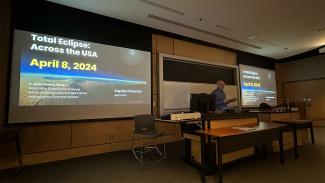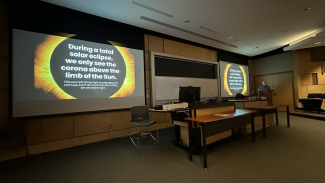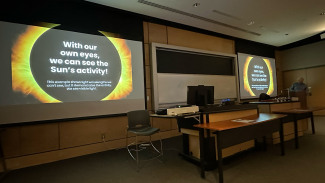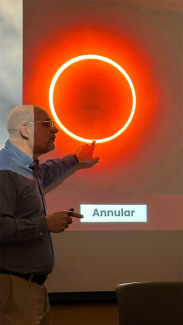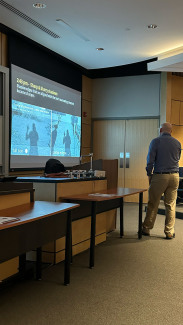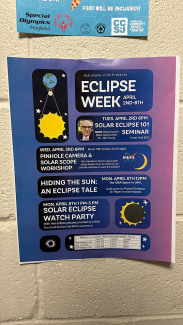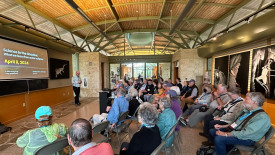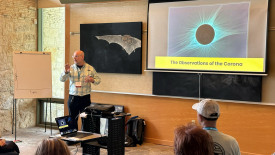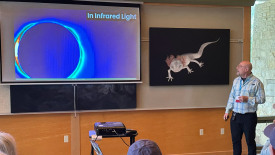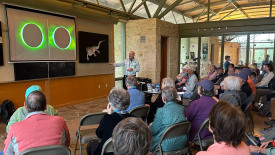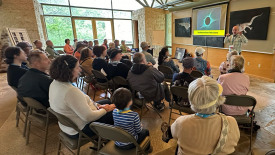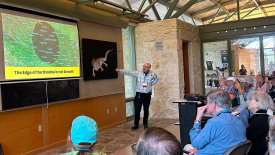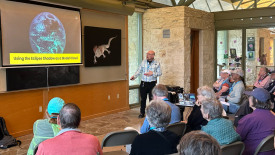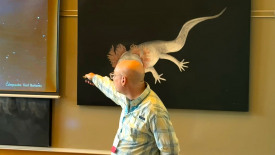I love talking to people about the solar system & beyond.
I enjoy the challenge of questions from people who are interesting in learning more about our universe. I try and respond with data, humor, the curiosity of a kid who loves science. No question is too basic. Complicated questions are an opportunity for researching answers and explaining concepts so others can understand.
NASA Hyperwall Talks
Sun and Moon Together Again: Helio Science from the Moon

“Sun and Moon Together Again: Helio Science from the Moon” presented by Alex Young at the American Geophysical Union (AGU) Fall Meeting in San Francisco, CA on December 9, 2019.
The Science of Space

“The Science of Space” presented by Alex Young. Originally presented at the Fall AGU 2017 conference on Monday, December 11, 2017 at 6:40 p.m.
Sunny with a Chance of Space Storms

Sunny with a Chance of Space Storms presented by Alex Young. Originally presented at the Fall AGU 2017 conference on Wednesday, December 13, 2017 at 3:30 p.m. CREDIT: NASA Scientific Visualization Studio
Lectures at Universities
Loyola University Maryland
04.02.24 – Total Eclipse: Across the USA
The Astronomy Club kicks off Eclipse Week with a lecture from C. Alex Young. The talk covers Solar Eclipse 101, including what to look for during partial and total solar eclipses, tips for viewing, comparisons of past eclipses. It also included a brief overview of space weather and the connection to the Sun’s corona. Click photos for a larger view.
10.11.23 – Solar Eclipse Science: Experience the Awe
On Wednesday, October 11th, Dr. Alex Young, a heliophysicist from NASA’s Goddard Space Flight Center, came to Loyola’s campus to give a talk about the science behind solar eclipses. He discussed the differences between annular and total eclipses, when and where future eclipses will be seen, and many more exciting facts about our sun. Students, faculty, and people from the community came to listen to Dr. Young’s presentation. More about Loyola’s Eclipse Week 2023 »
University of Alaska Fairbanks
Sunny with a Chance of Space Storms
January 28th, 2020 – Fairbanks Alaska – Dr. C. Alex Young from NASA Goddard visited Fairbanks for the Science for Alaska Lecture Series, hosted by the Geophysical Institute. His “Sunny with a Chance of Space Storms” lecture explored phenomena like sunspots, coronal mass ejections, the aurora, eclipses, and more.
Lectures at the Library of Congress
Heliophysics and the Parker Solar Probe
Thursday, December 6, 2018
James Madison Building – Pickford Theater (LM302), 101 Independence Avenue SE, Washington, DC 20540
NASA’s Alex Young will take a journey through the solar system, discussing how the Sun interacts at the largest and smallest scales, from complicated motions at the particle level to giant eruptions thousands of times bigger than the Earth. NASA studies the Sun and how its constant outflow of magnetic fields and solar material influences the very nature of space, the atmospheres of planets, and human technology. Heliophysics missions explore places never before visited—traveling through pockets of intense radiation, interstellar space, and right into the Sun itself. This summer NASA will launch the Parker Solar Probe, which will be the first spacecraft in history to fly through the Sun’s inner corona.
Speaker Biography: Dr. C. Alex Young is associate director for science, heliophysics science division at NASA Goddard Space Flight Center.
Transcript and more information »
CREDITS: Library of Congress
Total Solar Eclipse of 2017
C. Alex Young spoke about the science and wonder of total solar eclipses. He explained the celestial mechanics of the eclipse, viewing opportunities and how NASA will study the sun and Earth during this rare event on August 21, 2017.
Speaker Biography: C. Alex Young is a solar physicist and associate director for science at the Heliophysics Science Division at NASA Goddard Space Flight Center. He is responsible for overseeing and coordinating education and public outreach.
Transcript and more information »
CREDITS: Library of Congress
A Space Weather Report
C. Alex Young discussed the challenges of dealing with the harshness of space and making sure travelers can safely reach their destination as they reach for the planets and beyond. Speaker Biography: C. Alex Young is responsible for overseeing and coordinating education and public outreach at NASA’s Goddard Space Flight Center. Transcript and more information »
CREDITS: Library of Congress
2024 Total Solar Eclipse: Smithsonian Journeys
04.06.24 – Looking at All the Science Unique to Solar Eclipses
Click photos for a larger view.
Location: Westcave Discovery Center, for Smithsonian Journeys
The second lecture focused on several facets of the way things work that can only be explored during solar eclipses on Earth. The exciting part of this was the breadth of knowledge scientists can gain thanks to nature. The beginning discussed what can be learned about the Sun, its atmosphere, and the activity it sends our way over its 11-year activity cycle. The next part of the talk reviewed the studies that can and have been conducted to understand the fundamentals of our atmosphere, weather, and climate. This included understanding the mysterious interface to space, the ionosphere, and its impact on our technological society.
Next, a focus on the special experiments eclipses provide showed what we could learn about clouds and atmospheric dynamics. These experiments were not only those done by scientists from the ground, balloons, and airplanes but also with the special participation of the public and students. A unique aspect was the study of bacteria growth on Mars using the environment created by a total solar eclipse.
The last part discussed the new observations surrounding eclipse maps and the accuracy of eclipse timing and locations made possible by our modern data on Earth and lunar topography. All of this brought to light not only the unique opportunity for us but also the special science, thanks to one of nature’s most amazing phenomena.
Alex answered questions from the audience, including drawing a basic explanation of the solar cycle, and the impact on the corona for the 2017 eclipse vs. 2024.

04.05.24 – The When, Where, How, and Why of Eclipses
Location: The Stephen F Austin Royal Sonesta Hotel, for Smithsonian Journeys
The first lecture was a detailed look into the nitty gritty of when the eclipse would occur in Fredericksburg, Texas. This entailed a deep dive into what we could expect to see during a detailed timeline from the beginning to the end of the April 8 eclipse. The view of totality from the ground was compared to the different limited views available from space, along with detailed computer predictions of how nature would amaze us. We looked at the specifics of why we have eclipses, and the clockwork of the Sun, Moon, and Earth. We ended with a glimpse of upcoming eclipses for the next 20+ years around the world.
SXSW EDU 2018
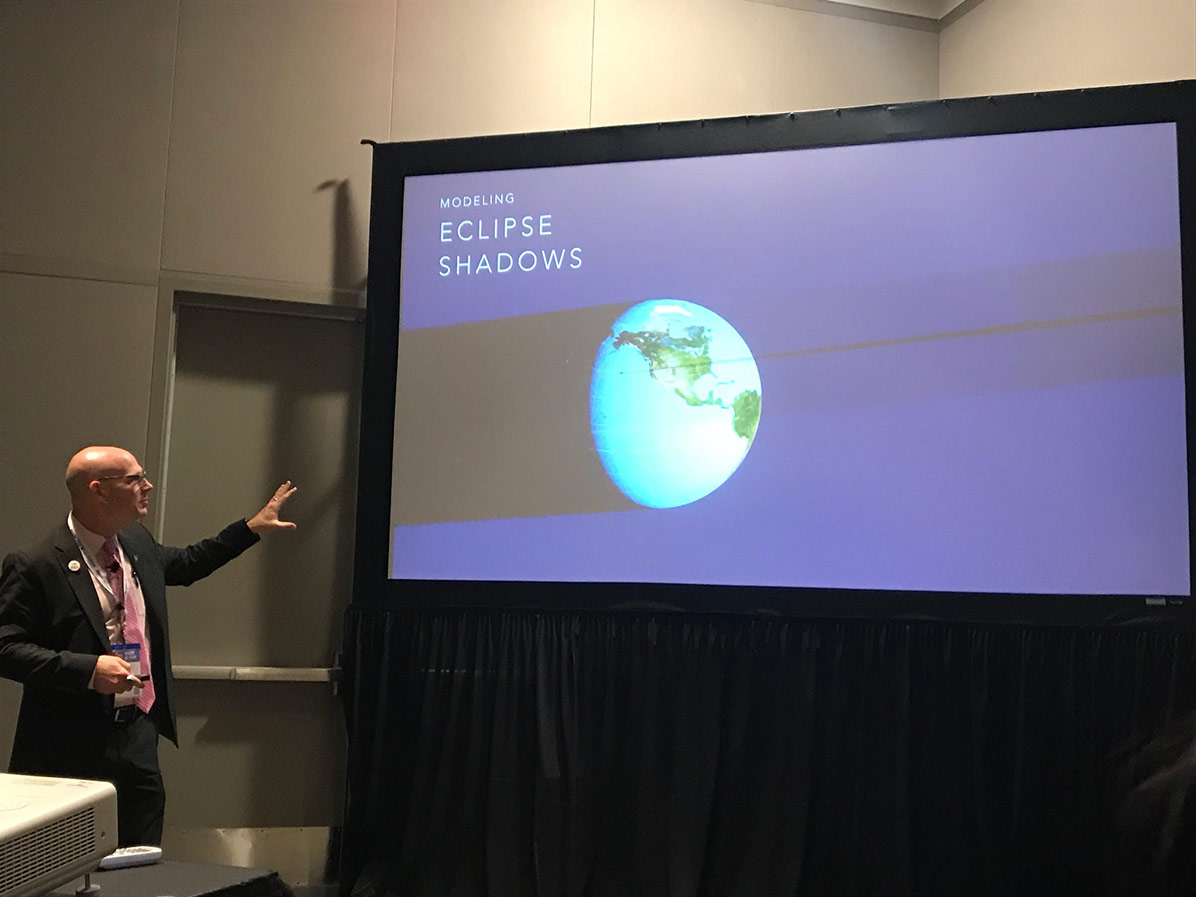
Bringing the Science: Teaching with Authentic Data
Quality media tools and resources needed for learners to engage in scientific practices such as analyzing and interpreting data and computer models are rarely produced for K-12 instructional use, or designed for diverse learners. WGBH has been working in collaboration with NASA and teachers across the country to develop learning resources that incorporate authentic data, tools, and supports needed for learners to work with data and computer models. We’ll share insights and best practices. Rachel Connolly, WGBH; Javier Montiel, Brazosport ISD; Dr. C. Alex Young, NASA #TeachingScience #SXSWEDU CREDIT: Jessica Lahey
Misc Speaking Events

February 18, 2017 – Dr. Alex Young tells us how the Sun’s magnetic activity results in solar storms, and how it affects life on Earth. CREDIT: National Solar Observatory

Solar Orbiter Q&A – February 11, 2020 – C. Alex Young, a Solar Astrophysicist and the Associate Director for Science in Heliophysics Division at NASA Goddard, took some time to talk with the participants of the Solar Orbiter NASA Social.
The 231st Meeting of the American Astronomical Society (AAS)
The 231st Meeting of the American Astronomical Society (AAS) at the Gaylord Resort and Convention Center in National Harbor, Maryland.
January 10, 2018 2:00 PM – 2:10 PM Author(s): C. Alex Young Institution(s):1.NASA Goddard Space Flight Center
Monday, August 21, 2017, marked the first total solar eclipse to cross the continental United States coast-to-coast in almost a century. NASA scientists and educators, working alongside many partners, were spread across the entire country, both inside and outside the path of totality. Like many other organizations, NASA prepared for this eclipse for several years. The August 21 eclipse was NASA’s biggest media event in recent history, and was made possible by the work of thousands of volunteers, collaborators and NASA employees. The agency supported science, outreach, and media communications activities along the path of totality and across the country. This culminated in a 3 ½-hour broadcast from Charleston, SC, showcasing the sights and sounds of the eclipse – starting with the view from a plane off the coast of Oregon and ending with images from the International Space Station as the Moon’s inner shadow left the US East Coast. Along the way, NASA shared experiments and research from different groups of scientists, including 11 NASA-supported studies, 50+ high-altitude balloon launches, and 12 NASA and partner space-based assets.
This talk shares the timeline of this momentous event from NASA’s perspective, describing outreach successes and providing a glimpse at some of the science results available and yet to come.
CREDITS
Contributing Teams: The Heliophysics Education Consortium
PRESENTATION TYPE: Research Contributed CURRENT
SESSION TYPE: Special Sessions (Accepting Orals) AUTHORS (FIRST NAME, LAST NAME): C. A. Young1
INSTITUTIONS (ALL): 1. Heliophysics Science Division, NASA Goddard Space Flight Center, Greenbelt, MD, United States.
2015 World Science Festival
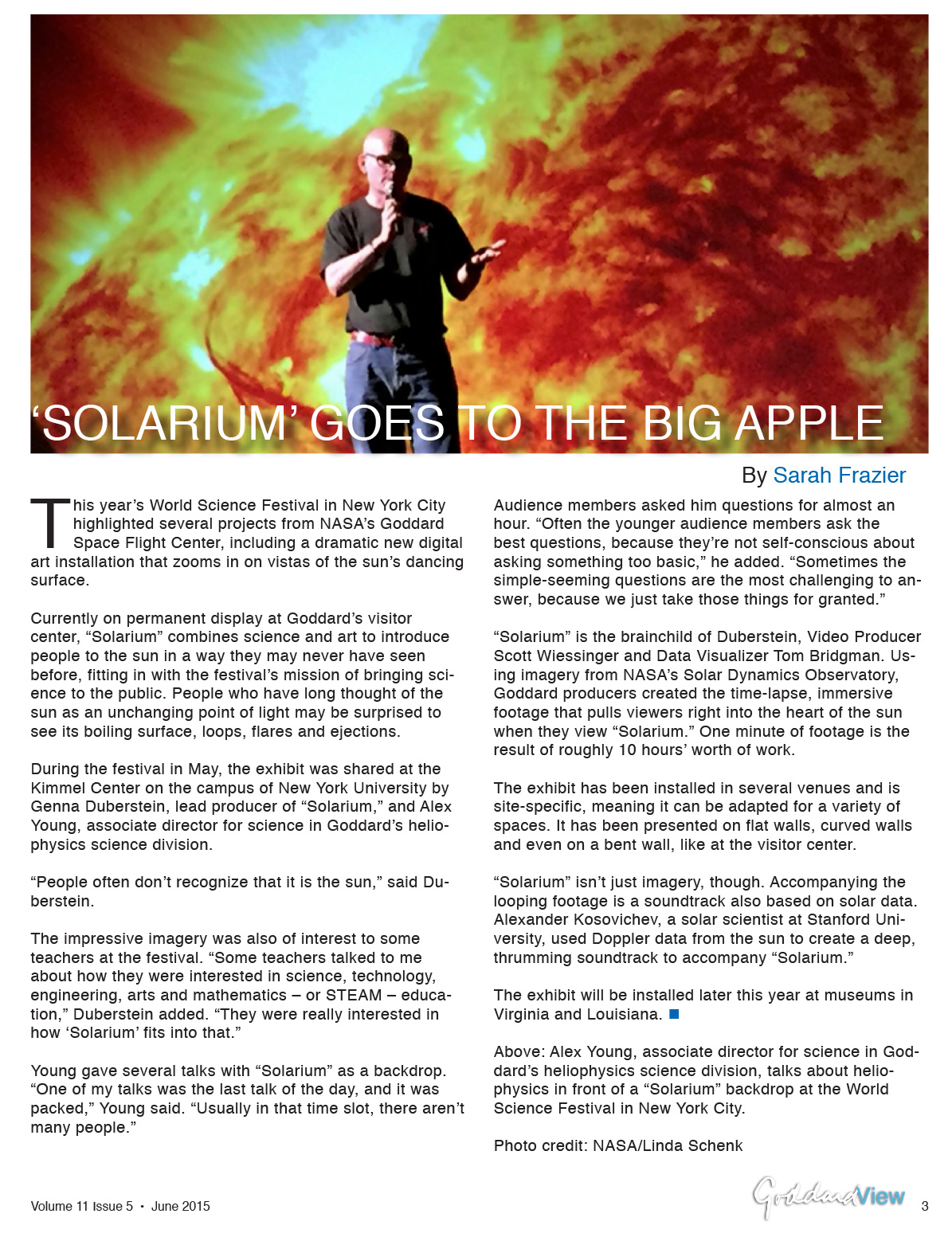
Museum of Science Fiction – Pilot Program with DC Public Schools
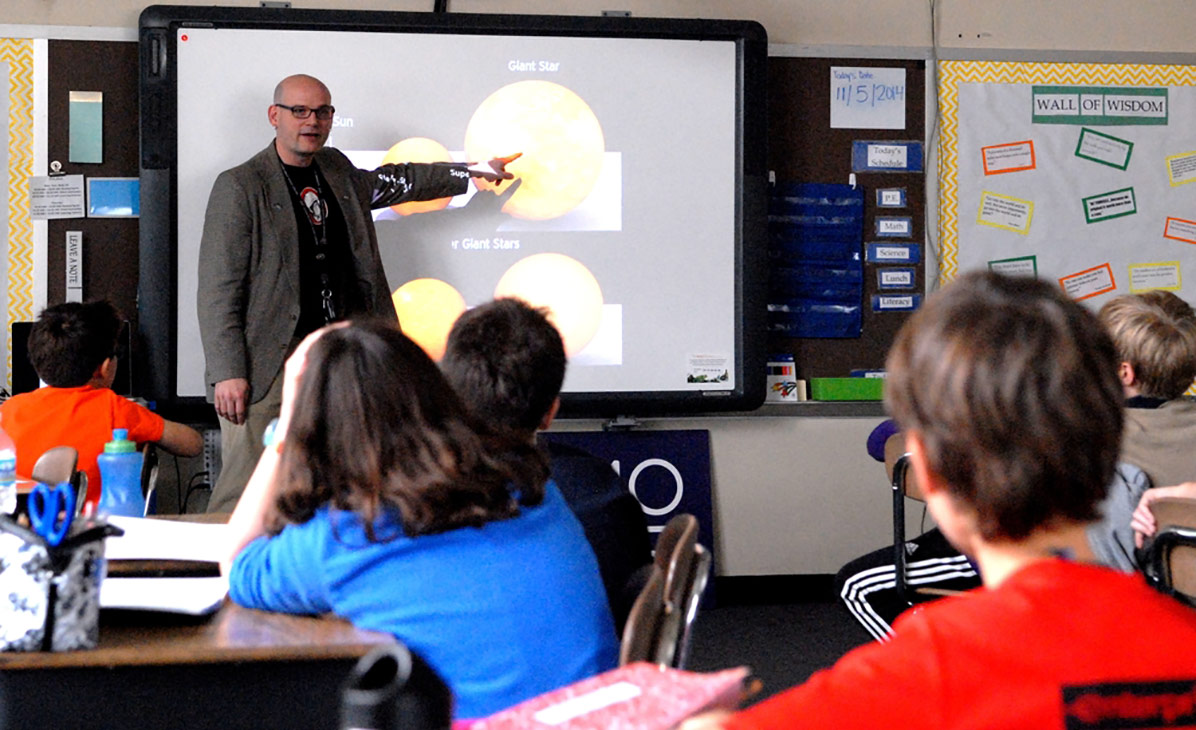
The primary objective of the DC Public Schools pilot program is to develop project-based learning activities with measurable outcomes. Lessons engage students in critical thinking. Students will compare science fiction and science fact through STEAM programming that uses Common Core and Next Generation Science Standards. The educational programming uses science fiction to foster a deeper interest in science and the arts. Click the photo to see Museum guest speakers teaching in the classroom. CREDIT: Museum of Science Fiction MORE »


